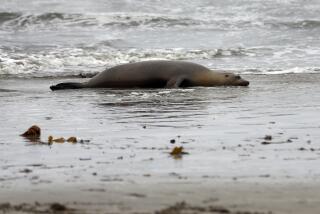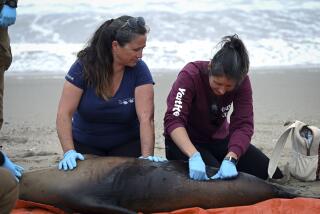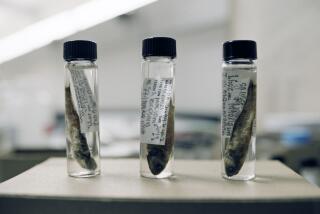Dolphin Deaths in East Blamed on Natural Toxin
- Share via
WASHINGTON — The mass deaths of 740 dolphins along the Atlantic Coast in 1987 and 1988 probably was caused by a natural toxin linked with “red tide,” but the animals also had record levels of PCBs in their bodies, the government said Friday.
In a final report issued by the National Oceanic and Atmospheric Administration, marine biologists said the cause of the mysterious dolphin deaths was brevotoxin, a potent poison produced by tiny ocean organisms that multiply in profusion under certain conditions, turning the water red.
The report was based on detailed autopsies on 17 of the dead dolphins that washed up on beaches from New Jersey to Florida from June, 1987, to February, 1988.
Scientists estimate that 50% or more of the entire coastal population of dolphins perished during an 11-month period.
In addition to brevotoxin, the report said PCBs--highly toxic polychlorinated biphenyls--were found in the blubber of some dead dolphins at levels “among the highest recorded for a cetacean.”
One male dolphin had PCB levels of 6,800 parts per million, the highest level ever found in a marine mammal and far above the 5 parts per million standard set by the government for fish for human consumption.
The report acknowledged the PCBs could have contributed to the dolphins’ deaths and said more research was needed to answer whether contaminants at levels found in the dolphins might make them more susceptible to brevotoxin or disease.
However, it said the 1987-1988 outbreak occurred too suddenly for PCBs to be considered a likely cause.
It said PCB residues would have had to move from the dolphin’s blubber to the bloodstream in an improbably short time.
The study noted that red tide is typically found in the Gulf of Mexico, but it said studies show ocean currents could have transported the noxious plankton blooms to waters off eastern Florida and North Carolina at roughly the time of the outbreak.
More to Read
Sign up for Essential California
The most important California stories and recommendations in your inbox every morning.
You may occasionally receive promotional content from the Los Angeles Times.










